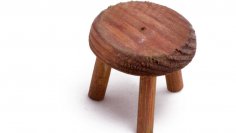
I believe there's no need to go into detail about the backless piece of furniture called a stool. In common parlance, this item is called a “taburetka.”
We remember it from the film “Chapayev,” when Vasily Ivanovich, in the heat of passion, slammed the stool to the floor. Some, I think, remember this object from Marshak's poems, where Uncle Styopa, due to his great height, rested his legs, which dangled over the edge of the bed, on the stool.
Some male readers in Soviet-era shop classes were even “lucky enough” to cut boards and slats and make stools out of them. I confess, I did this myself. True, my stools rarely earned a B in design—a C was the usual grade for my work. But from that very moment on, I developed a respect for the work of carpenters, even through my calluses.
Even in rural areas, where beautiful furniture is abundant in stores, stools are still popular. They are undoubtedly very practical, durable, and inexpensive. I wonder when the stool first became a fixture in our homes?
Archaeologists and historians say the oldest stool-like finds date back to roughly the time when humans moved from caves to primitive dwellings. Before then, people used large, flat stones for sitting. But these were cold and heavy to carry when space needed to be cleared in a cave. Stones began to be replaced with fallen tree trunks.
Then people came up with the idea of using stone axes to carve seats out of tree trunks and then chop the trunks into sections equal to the number of seats needed. With the advent of metal tools, they began making supports for the “seats” out of thinner tree trunks, shaped like legs. However, nails didn't exist back then, so the “legs” were glued to the “seat” with liquid clay. When it dried, it created a fairly strong bond. Then came the saw, chisel, and nails—and the process, as they say, began.
Interestingly, the stool is well known in almost every country. It was unknown only to those cultures where it was customary to sit on the ground—for example, on skins or carpets. Even the pharaohs of Egypt and kings in European countries used the stool. For beauty, craftsmen shaped the stool to resemble a throne and lavishly decorated it with jewels.
Over time, the stool began to be “refined.” People began adding a backrest and armrests. Eventually, it was no longer a stool, but a kind of primitive chair. Subsequently, the stool and the chair diverged in technology.
The classic stool has four legs and a wide board on top. Nowadays, the technology has undergone only minor changes: wooden legs have been replaced with metal and plastic, and the seat is made of plastic or thick plywood.
However, to be fair, it should be noted that some furniture companies made more significant changes. In the middle of the last century, folding stools with movable legs appeared on the market. These stools were convenient to use not only at home, but also in the countryside or outdoors.
Unfortunately, this innovation didn't gain widespread popularity due to the care it required. People often injured themselves when unfolding the stool—fingers accidentally got caught between the legs and pinched. This was especially true when the legs were extended by powerful springs.
Single-legged “screw-in” stools also didn't catch on—they were quite unstable. However, the idea itself is now used in office and computer chairs, with some improvements.
The stool is the most widely produced piece of furniture today, and it's manufactured on an industrial scale. There are kitchen stools, bar stools, garden stools, and camping stools.
A stool is an object to which a person erected a monument. It stood on Taganskaya Street in Moscow and was unveiled in April 2007. It was notable for its inscription humorously asking people not to sit on it. At three meters tall, few would have considered relaxing on such a stool.
Unfortunately, the stool monument was removed in April 2015. The reason for this is unknown to me.





